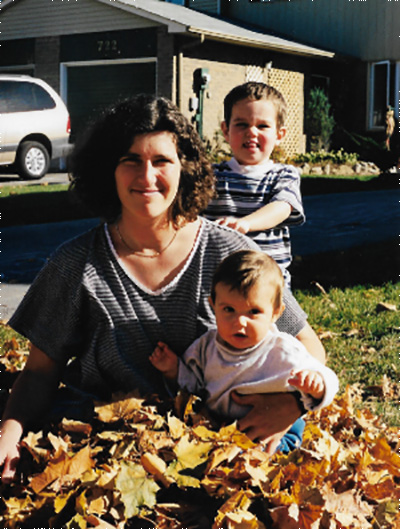Adam Hoerdt is cycling across Canada to raise funds for life-saving ARVC research. Adam lost his wife to ARVC in 2001, and his son is currently in a vegetative state. (Photo: Courtesy Adam Hoerdt)
On a sunny day in June 2001, Adam Hoerdt and his wife, Jackie, took their positions in the outfield of a softball game. In the middle of the inning, Jackie collapsed. While they waited for an ambulance, a teammate performed CPR – but to no avail. Jackie had suffered a fatal cardiac arrest. She was only 31.
The family was offered no immediate explanation as to what caused the cardiac arrest. Jackie was a fit and seemingly healthy young adult. A mother of two boys, one-year-old Ben and three-year-old Greg, with no pre-existing health conditions.
“Even when the autopsy came back, the results were inconclusive,” explains Adam. “There were a few theories, none of which were presented with any confidence. They just didn’t know.”
Devastated by his sudden loss, Adam focused on raising his boys “with Jackie’s spirit in mind.”
It wasn’t until 2018, when Greg collapsed and was resuscitated at work, that questions surrounding Jackie’s death resurfaced.
During his five-week hospital stay, doctors diagnosed Greg with arrhythmogenic right ventricular cardiomyopathy (ARVC). The coroner’s office recovered Jackie’s autopsy report, along with slides of her heart tissue. Seventeen years after her death, doctors confirmed ARVC had caused her cardiac arrest.
The first symptom can be the last
ARVC is a genetic heart condition that causes an abnormality in the muscular wall of the heart. Proteins that hold the cells of the heart muscle together do not develop properly, leading to abnormal heart rhythms, and an increased risk of sudden cardiac arrest, heart failure, and death.
Symptoms are typically delayed, and the first symptom can be the last. In fact, ARVC is most often diagnosed after the sudden death of an individual in their 20s or 30s. Increasingly, ARVC is diagnosed in patients presenting with heart arrhythmias, episodes of fainting, or the gene has been identified in another family member.
The key to combating ARVC is early detection and monitoring. Medication, altered exercise routines, and, in some cases, implanting a defibrillator can avoid dire consequences.

As of today, seven of Jackie’s family members have ARVC, including Adam and Jackie’s youngest son, Ben. They are monitored closely by Dr. Danna Spears, Medical Director, Cartwright Inherited Cardiomyopathy and Arrhythmia Program, Peter Munk Cardiac Centre. Dr. Spears is involved in ongoing cardiomyopathy research, a primary focus of the Cardiac Precision Medicine Program.
“2018 was the first time anyone in our family had heard of ARVC,” Adam says. “I never dwelled on the cause of Jackie’s death. But knowing that her death could be explained – even if not entirely avoided – it felt as though a huge weight had been lifted off my shoulders – a weight I didn’t even know was there.”
Greg underwent surgery for an ICD (implantable cardioverter defibrillator), and spent the next two years living his life to the fullest. Sadly, two years later, Greg suffered another cardiac arrest and his heart did not respond correctly to the ICD. He is currently in a vegetative state.
‘We can’t control everything that happens to us, but we can choose how to respond’
“After Greg’s cardiac arrest in 2020, I said ‘enough is enough, I have to do something.'”
To take action against the disease that has devastated his family, and to preserve his own mental health, Adam set out on a cross Canada bike ride in 2021, covering Atlantic Canada, Quebec, and Ontario. The ride continues this month, when Adam will cycle from Victoria to Waterford, Ont.
Proceeds from the ride will help sponsor an ARVC fellow at the Peter Munk Cardiac Centre, furthering life-saving ARVC research. Read how to support the ARVC fellowship.
“The Peter Munk Cardiac Centre has been instrumental in helping our family navigate the scary and uncertain path that is ARVC,” Adam says. “The research has come a long way since we lost Jackie in 2001 – but there’s still a ways to go.
“I want to do everything I can to lessen the risk for future generations.”
Thanks to Adam efforts, an ARVC community has emerged in Canada, offering members much needed peer-to-peer support.
“Without a doubt, the highlight of last year’s ride was the people,” Adam says. “To meet families like us – who’ve been to hell and back with this disease – is so important. As a parent, this doesn’t get any easier. But talking to other ARVC families gives me the strength to keep going.”
“As Jackie’s brother says, ‘we can’t control everything that happens to us, but we can choose how to respond. This is how I’m choosing to respond.”
